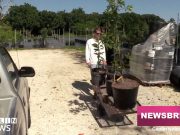Earlier this year, Miami-Dade County Mayor Daniella Levine Cava marked Earth Day with a beach clean-up, and the county has continued the environmental efforts ever since.
With Florida being such a major, international tourist destination, it often opens up the likelihood that litter can overwhelm the coastline, one of the state’s most iconic attractions. The beaches often see an uptick in tourist traffic – and litter – in early March as spring breakers leave bags of trash on South Beach. And it doesn’t stop there, as the tourist-heavy summer months create the worst time for beach pollution.
But Miami-Dade County is fighting back. At attractions like the Matheson Hammock Park and Marina — one out of ten parks conducting coastal clean-ups during the summer – work is being done to minimize the amount of trash left on the county’s shores.
“Since I’ve started here a year ago, I’ve seen less and less garbage than when we started,” Marjorie Suarez, Marina Manager II at the Matheson Hammock Park, said. “I’ve noticed the volume of trash on shore is a lot less.”
According to the Miami Beach Anti-Litter campaign, the trash that collects on the shores of Miami’s beaches is estimated to be around 8,000 pounds a day with debris ranging from cigarette butts to plastic bags to Styrofoam cups.
Levine Cava’s clean-up push has been aided by environmental organizations, as well. In two separate weekends this year, volunteers worked to reduce the volume of waste on Miami-Dade’s beaches. The Ocean Conservancy hosted the International Coast Clean-Up day, where the county collected a record of 17,771 pounds of waste, and Biscayne Bay hosted its annual Baynanza Clean-up, collecting around 1,200 pounds of trash.
Events like those definitely help, and as part of the county’s extended coastal clean-up series, the beaches from May through July are in better shape. But that’s just the beginning, and if more year-long clean-ups like the one at Matheson Hammock Park become the norm, the county’s coast will be much better off.
“Our park is really big, and we’re right by the shoreline and marinas, so every day, we do different locations around the park,” Suarez said. “Our staff knows that if they see something, pick it up and throw it away.”
Matheson Hammock Park also works with residents volunteering their time to clean up the park. Organizers know you can never have too much help.
“We have student volunteers throughout the school year,” Suarez said, “and we often work with Coral Gables to clean up the nearby parks.”

































